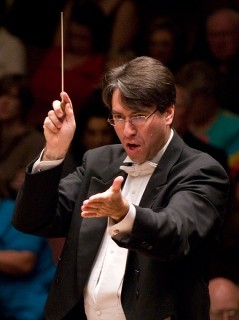|
Back
The Passion and the Mystery New York
Isaac Stern Auditorium, Carnegie Hall
02/21/2015 -
Alberto Ginastera: Turbae ad passionem gregorianam, opus 43
Charles Ives: Symphony No. 4
Thomas McCargar (Baritone), Geoffrey Silver (Tenor), Scott Allen Jarrett (Baritone, Conductor of Distant Choir)
The Choir of Trinity Wall Street, The Washington Chorus, Trinity Youth Chorus, Washington Chorus, Washington National Cathedral Choir of Boys and Girls, NOVUS NY, Tim Andres (Solo Piano), Julian Wachner (Conductor)

J. Wachner (© Courtesy of the Artist)
New Yorkers last night had two major choices in Carnegie Hall. Those into “hard-core” dissonance could have walked downstairs where the Theater of Voices were doing Karlheinz Stockhausen’s Stimmung. For myself, I plunked for “soft-core” 20th Century; Charles Ives and a bafflingly unknown gigantic Passion oratorio by Alberto Ginastera.
Yet there was even a more important reason, and that was to watch conductor Julian Wachner at work. He is the archetypical New York international conductor. Not known to ”subscriber” concertgoers. But every performing artist knows him for his inspiration, his brilliant technique (he conducted without a baton and without assistants, both the Ives Fourth and the mammoth Ginastera work), and for an obvious electric relationship with his players.
And of course for making this sometimes difficult music become both transparent and moving.

C. Ives/A. Ginastera (© Wikipedia/YouTube)
As he admitted in the program notes, the Ives symphony is hardly unknown–and the affable conductor gave a splendid short introduction showing how the work’s so called dissonances are basically a recipe of well-known ingredients thrown together.
Performing this piece is not as easy as explaining it. Mr. Wachner did need an assistant (Scott Allen Jarrett) to conduct the huge chorus, which took up both sides of the first balcony. But Ives, whose business practicality was the opposite of his music practicality, retained that chorus for only the beginning and end. So he must have known that it would take almost 50 years for its performance. And then, only a Stokowski would have the guts, bravura and financial influence to do this.
Yet the Fourth Symphony is mainly an orchestra work, beginning with that zinger of a first chord, the stuff that makes Christopher Rouse’s music sound like a Telemann recorder concerto. From then on, those reverberant acoustics of the Isaac Stern Auditorium did their part in blasting away with the first and second movements. As for the Fugue, I would love to lean over to perfect strangers and say, “Hey, listen to those last measures. We got a big Christmassy surprise waiting!!”
The finale was allowed to fade away to almost nothingness. And oh, how happy I was that no “subscription audiences” were around to applaud before the final pianissimo notes and those two measures of silence.
Ives himself, in one of those ineffable quotes, wrote his publisher not to worry about “wrong notes”, since “what is wrong is right.” Except that in my recordings, it is difficult to find who is playing what. Only in a live performance like this can you watch the double-basses and chamber strings and flutes and see how much Charles Ives could and did accomplish.
The second work, lasting nearly an hour, was a revelation. Apparently Mr.Wachner’s relationship to the Argentinian composer was pre-birth, since his mother had been playing the Piano Sonata for a performances while he was still in the belly.
But even he was astonished to find this work, written in 1976, four years before his death. It is called a “Passion”, but from the looks of the stage, it was obviously a Mass–a mass of the 90-piece NOVUS orchestra, four of Mr. Wachner’s own choruses (The Choir of Trinity Wall Street, The Washington Chorus, Trinity Youth Chorus, Washington Chorus) and the Washington Cathedral Chorus of Boys and Girls. They went way over the stage, and performed nobly, good balance, eloquent Latin.
What they sung, and what the three “Gregorian” soloists chanted, and what the NOVUS Orchestra played was more than stunning. It is easy to say that this could be one of the most brilliant religious works of the past half-century.
Mr. Wachner describes the 12-tone work as resembling Messiaen, but I felt nothing of Messiaen at all. Instead, this was akin to Penderecki’s St. Luke Passion, both in structure, and in the placing of ancient music with the most dissonant modern tones.
And it had the same startling effect as the Penderecki. Starting with a low held note and the Gregorian-style recitative by the so-rich baritone of Thomas McCargar to choruses which reached the most dramatic climaxes. This is where the freeing of Barrabas, one of the most dramatic parts of the Passion started with whispering from the chorus to a full-blown shout.
We had the same choral sense of a 13th Century Mystery Play after Jesus (the understated baritone Scott Allen Jarrett), says that one of his disciplines will betray him. The Biblical Latin for “Surely not I, Lord” starts again with aleatoric murmur, growing up to a babble of negativity. (With Ginastera’s music, we can almost see the disciples pushing each other to speak, to deny, and then getting the courage to speak–as if “to protest too much.”)
While the description of this as a “12-tone piece” could frighten some, Ginastera used that technique the way it should be used: as a harmonic tool to show horror, madness, anxiety and fear. For the end–a climax that is as reverent and telling as any Passion–Mr. Ginastera turned Alleluia. Deo Gratias into a magnificent oh so tonal chord of pure D Major.
The mystery of this Mystery Play is why no recordings have ever been made, for Ginastera’s breadth, inspiration, changes of mood and, above all, his sense of choral theater is overwhelming. I have no idea whether Mr. Wachner would be willing to make this recording, but if so, he would have a ready audience in those who gave him and his forces an immediate and appropriate standing ovation.
Harry Rolnick
|